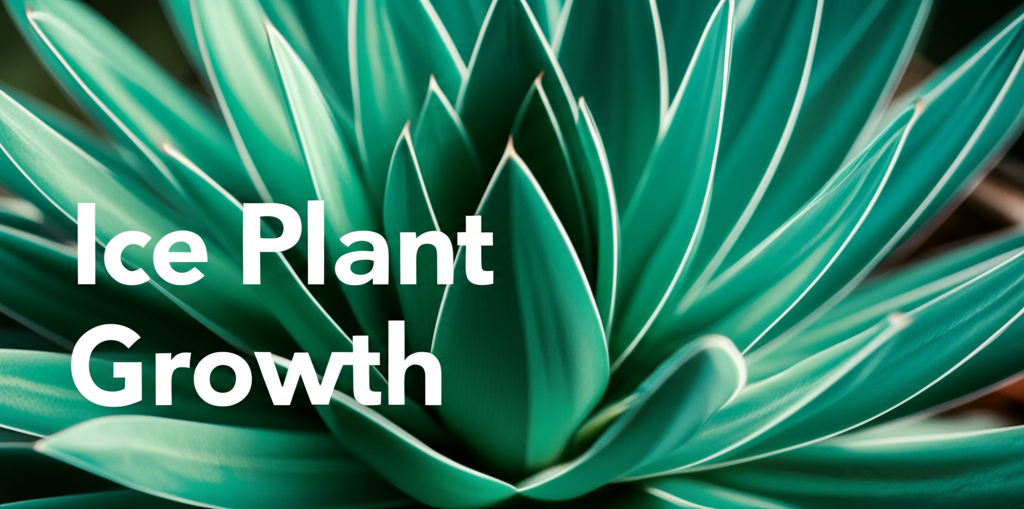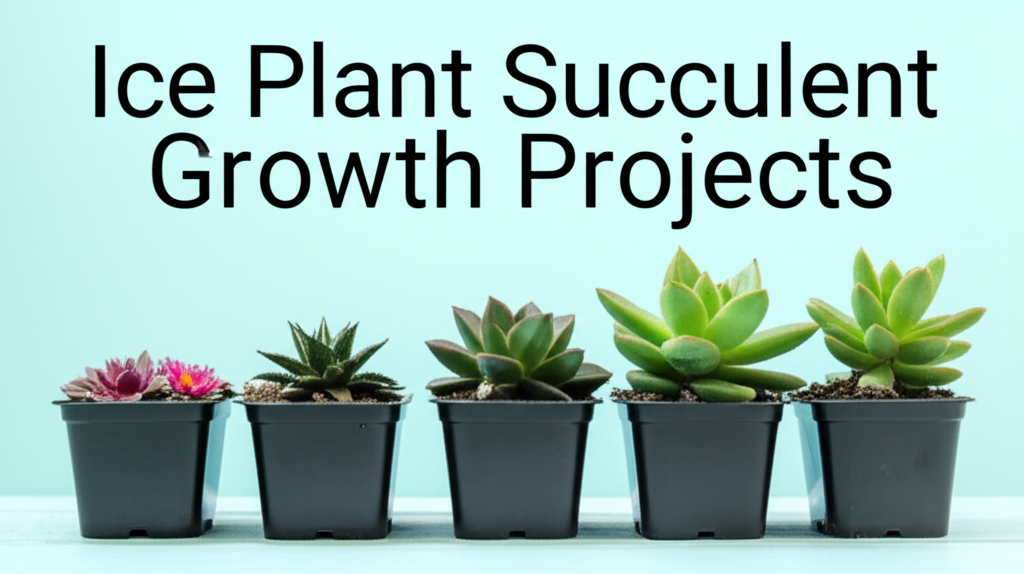The Mesmerizing World of Ice Plant Succulents
Ice plant succulents, scientifically known as Mesembryanthemum, are a fascinating group of plants celebrated for their unique, water-filled epidermal cells that resemble tiny ice crystals. These shimmering structures, or papillae, not only give the plants their characteristic name but also play a crucial role in their survival, reflecting excess sunlight and collecting dew in arid environments. Their rapid growth, vibrant colors, and adaptability make them ideal candidates for engaging time-lapse photography projects, offering a captivating glimpse into the often-unseen processes of plant development.
Whether you’re a seasoned horticulturalist, a budding botanist, or simply a lover of visual storytelling, embarking on an ice plant succulent time-lapse project can be an incredibly rewarding experience. It allows us to appreciate the subtle yet powerful forces driving plant life, transforming the slow march of growth into a dynamic and easily digestible visual narrative.
Why Choose Ice Plants for Time-Lapse?

Several factors make ice plant succulents particularly well-suited for time-lapse growth projects:
- Rapid Growth: Many ice plant varieties exhibit relatively fast growth rates, especially when provided with optimal conditions. This means you can capture significant changes within a manageable timeframe.
- Visual Appeal: The glistening papillae, coupled with their often bright and cheerful flowers, provide a visually dynamic subject. The changes in these structures and the overall plant form are often striking.
- Resilience: Ice plants are generally hardy and forgiving succulents. While they have specific needs, they are less prone to sudden demise than some more delicate species, making them more reliable subjects for long-term observation.
- Variety: The diversity within the Mesembryanthemum genus means you can experiment with different species, each offering unique textures, colors, and growth habits.
Key Facts and Comparison: Popular Ice Plant Varieties for Time-Lapse
When selecting an ice plant for your time-lapse project, considering the specific characteristics of different species can enhance your results. Here’s a look at some popular choices:
| Species/Variety | Key Characteristics | Growth Habit | Flower Color | Time-Lapse Suitability |
|---|---|---|---|---|
| Mesembryanthemum crystallinum (Common Ice Plant) | Large, fleshy leaves covered in prominent, glistening papillae. Can become sprawling. | Low-growing, spreading groundcover. | White to pale pink. | Excellent. Displays noticeable leaf development and flower opening. |
| Delosperma cooperi (Hardy Ice Plant) | Smaller, cylindrical leaves. Very resilient to cold. | Low, mat-forming groundcover. | Vibrant magenta/purple. | Good. Flowers prolifically, showcasing bud formation and bloom. |
| Lampranthus spectabilis (Showy Ice Plant) | Fleshy, triangular leaves. Densely branched. | Bushy, upright to spreading. | Bright pink, orange, red, yellow. | Very Good. Known for abundant and colorful blooms, offering dynamic flowering sequences. |
| Aptenia cordifolia (Heartleaf Ice Plant) | Heart-shaped, bright green leaves. Can be invasive in some regions. | Trailing, creeping groundcover. | Small, yellow or pinkish. | Moderate. While it grows quickly, its visual changes might be less dramatic than others for time-lapse. |
Setting Up Your Ice Plant Time-Lapse Project
A successful time-lapse project requires careful planning and execution. Here’s a breakdown of the essential steps:
1. Choosing Your Subject and Container
- Plant Selection: As highlighted above, select an ice plant variety known for its growth and visual appeal. Starting with a young plant or seeds will allow you to capture the entire growth cycle.
- Potting Mix: Use a well-draining succulent or cactus mix. A good mix will prevent waterlogging, which is detrimental to succulents. You can create your own by combining potting soil with perlite or coarse sand.
- Container: Opt for a terracotta or ceramic pot with drainage holes. The pot size should be appropriate for the plant’s current size, allowing for growth. Avoid over-potting, as this can lead to compacted soil and root rot.
2. Providing Optimal Growing Conditions
- Light: Ice plants thrive in bright, direct sunlight. Place your chosen plant in a location that receives at least 6-8 hours of sunlight daily. A south-facing window indoors or a sunny spot outdoors is ideal.
- Watering: The key to succulent care is to water deeply but infrequently. Allow the soil to dry out completely between waterings. Overwatering is the most common cause of succulent death. During the time-lapse, observe the soil moisture and adjust your watering schedule accordingly.
- Temperature and Airflow: Most ice plants prefer warm temperatures, typically between 65-75°F (18-24°C). Good air circulation is also important to prevent fungal diseases.
3. Essential Equipment for Time-Lapse
- Camera: A DSLR, mirrorless camera, or even a high-quality smartphone with a time-lapse feature will suffice.
- Tripod: A sturdy tripod is non-negotiable for keeping your camera perfectly still throughout the project. Even slight movements can ruin the time-lapse effect.
- Intervalometer/App: This device or app controls the camera, taking photos at set intervals. Many cameras have built-in intervalometers, or you can use external ones or smartphone apps.
- Power Source: For longer projects, a continuous power adapter for your camera or spare batteries are essential to avoid interruptions.
- Lighting (Optional but Recommended): Consistent lighting is crucial for smooth time-lapses. If natural light is inconsistent, consider using artificial grow lights or softboxes.
4. Setting Up the Shot
- Camera Placement: Position your camera on the tripod to frame the plant attractively. Ensure the entire plant, including its growth area, is within the frame.
- Interval Setting: The interval between shots depends on the expected growth rate. For fast-growing ice plants, intervals of 15-30 minutes might be suitable. For slower growth or to capture finer details, you might opt for 5-10 minute intervals. Experimentation is key.
- Focus: Set your camera to manual focus to ensure the plant remains sharp throughout the entire sequence.
- Exposure: Use manual exposure settings. This prevents the camera from adjusting brightness between shots, which can cause flickering in the final time-lapse.
5. Capturing the Time-Lapse
- Start: Once everything is set up, begin your intervalometer.
- Consistency: Maintain consistent lighting and avoid disturbing the plant or camera setup.
- Monitoring: Periodically check the plant’s watering needs and ensure the camera is still functioning correctly.
- Duration: The length of your project will determine the total number of photos taken. A project capturing several weeks of growth might involve thousands of images.
Processing Your Time-Lapse Footage
After capturing your images, the next step is to assemble them into a seamless video.
1. Image Editing (Optional but Recommended)
- Batch Editing: Use software like Adobe Lightroom or similar programs to make adjustments to your images. This can include white balance correction, exposure adjustments, and cropping. Ensure you apply the same edits to all images for consistency.
- Renaming: Organize and rename your image files sequentially (e.g., IMG_0001.jpg, IMG_0002.jpg) to make importing into video editing software easier.
2. Assembling the Time-Lapse Video
- Video Editing Software: Import your image sequence into video editing software such as Adobe Premiere Pro, Final Cut Pro, DaVinci Resolve, or even simpler programs like iMovie.
- Frame Rate: Choose a frame rate for your video. Common frame rates are 24, 25, or 30 frames per second (fps). A higher frame rate will result in a smoother but faster playback of the growth.
- Rendering: Render your video into a usable format like MP4 or MOV.
Troubleshooting and Tips for Success
Even with careful planning, you might encounter challenges. Here are some tips to ensure your project runs smoothly:
Pros and Cons of Ice Plant Time-Lapse Projects
Embarking on this type of project has its advantages and disadvantages. Understanding these can help you set realistic expectations.
| Pros | Cons |
|---|---|
| Visually Captivating: Demonstrates plant growth in a dynamic and engaging way. | Time-Intensive: Requires consistent monitoring and image capture over extended periods. |
| Educational: Provides a deeper understanding of plant biology and development. | Technical Setup: Requires specific equipment and some technical proficiency. |
| Rewarding Outcome: Creates a unique piece of visual content. | Environmental Variables: Changes in light, temperature, or pests can affect results. |
| Accessible Subjects: Ice plants are relatively easy to grow and find. | Potential for Gaps: Technical failures or power outages can create missing frames, disrupting the flow. |
| Therapeutic: The process can be calming and meditative. | Storage Requirements: A large number of high-resolution images can consume significant storage space. |
Common Issues and Solutions
- Flickering: Inconsistent lighting is the primary cause. Ensure consistent light exposure or use artificial lighting. Auto-exposure can also cause flickering; manual settings are preferred.
- Blurry Images: Ensure your tripod is stable and the camera is securely mounted. Use manual focus. Check if the plant is moving due to drafts.
- Missing Frames: Ensure sufficient battery power or use a continuous power source. For long projects, consider external storage for your camera if it supports it.
- Plant Health Issues: Improper watering, poor drainage, or insufficient light can harm your plant. Monitor soil moisture closely and adjust care as needed.
- Camera Malfunction: Keep spare batteries, memory cards, and be familiar with your camera’s operation. Protect your equipment from dust and moisture.
Beyond the Basics: Enhancing Your Project
Once you’ve mastered the fundamentals, consider these advanced techniques:
- Focus Stacking: For extreme close-ups, consider focus stacking to ensure a greater depth of field. This involves taking multiple shots with different focus points and blending them in post-processing.
- Motion Control: For more dynamic camera movement, explore motion control sliders or robotic heads.
- Environmental Control: If you have the resources, using a controlled environment like a grow tent can ensure optimal and consistent conditions, minimizing external variables.
- Music and Sound Design: Add background music or subtle sound effects to enhance the emotional impact and viewing experience of your time-lapse video.
- Time-Lapse of Seed Germination: Start from seed to capture the entire life cycle, from germination to mature plant. This offers a longer but incredibly detailed journey.
Conclusion: The Art of Observing Growth
Ice plant succulent time-lapse growth projects offer a unique opportunity to connect with the natural world in a profound way. By carefully planning your setup, providing optimal care, and patiently capturing the subtle transformations, you can create a mesmerizing visual record of life’s quiet yet persistent progress. It’s a testament to the beauty of slow, steady change and a rewarding endeavor for anyone interested in horticulture, photography, or simply appreciating the marvels of nature. So, gather your equipment, choose your ice plant, and begin capturing the unseen – the magic of growth unfolding before your eyes.


